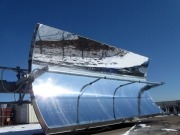
If Australia had the right social and political leadership it could drive forward deployment of solar and wind in order to achieve full self-sufficient renewable energy within 10 years the report states. The programme, if implemented, could be an example to the whole world and enable to Australia to end its current reliance on fossil fuels completely.
Australia is currently the world’s largest exporter of coal and also has one of the highest global greenhouse gas emissions rates per capita. The country has, until fairly recently, been particularly obstinate in its resistance to tackling climate change. The University of Melbourne report says that with the right political will Australia’s enormous renewable potential could be harnessed within a decade, creating thousands of new jobs and making the country carbon neutral.
Around 40% of Australian renewable energy could be generated by wind farms but the real key to success would be the enormous empty landscape of the interior with the high levels of solar power it receives.
An example of suitable technology is the Gemasolar power station in Spain which is a 19.9MW plant expected to generate 110 GWh per year. The plant’s molten storage tank allows for independent electrical generation for up to 15 hours. Although solar power in Australia could be produced from solar PV arrays on buildings, most of the country’s solar power could come from concentrated solar power (CSP) plants similar to that in Spain. CSP incorporates huge towers containing salt water with sunlight directed on to them from fields of mirrors. The heated water drives turbines and such plants could therefore supply some 60% of Australia’s electricity demand. Surplus heat could be stored in underground molten salt storage tanks which would release heat during the night. This would enable the plants to run continuously. Backup plants burning biomass, much of it waste material from agricultural land, could operate on those days deficient of sunlight and any gaps could be filled by Australia’s existent hydro-electric power.
The report concedes that energy efficient would need to be improved but says such a task is perfectly possible. The authors of the report point to the example of Germany where per capita electricity use is 30% less than that of Australia with policies in place to achieve further reductions over the next 20 years. Germany also has a high level of industrial activity and a high standard of living.
Australians would have to switch to new electric cars and trains but the report says that this is also perfectly possible. The overall cost of a total switch to electricity would be around 3% of annual GDP, approcimately A£37 billion (US$39 billion) over 10 years with an added 6.5 cents per kWh added on to the electricity price. 23 wind farms, each capable of generating 2,000 to 3,000MW would be sited around Australia with 12 CSP plants, each incorporating several towers. The CSP plants would also have 18,000 dual-axis tracking mirrors focusing sunlight on the towers.
A 100% renewable energy grid could create at least 80,000 jobs during construction and 45,000 in operation. 30,000 jobs would also be created in manufacturing assuming half the plant was made in Australia itself.
Further information:
Zero Carbon Australia (report)

